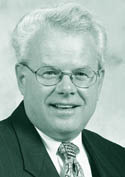|
This is an archived article.
For the latest news, go to the
Advance Homepage For more archives, go to the Advance Archive/Search Page. 
| ||
|
Could UConn do better in the area of sponsored research development? Like the effects of El Niño, recent discussions on this topic have sometimes been turbulent. But it's something we should be discussing.
None of these facts diminishes the excellent quality of sponsored research conducted by UConn faculty, students, or staff. But they do raise the question of whether different internal policies might improve our chances of getting more extramural support. The issue has arisen in light of the more than 150 new faculty hired in the past few years, the improved facilities for research provided by UConn 2000, and the development of innovative partnerships such as the UConn-African National Congress human rights cross-cultural program. The Research Advisory Council and several academic deans have recently discussed ways to enhance sponsored research development. Three strategies have been suggested:
When the 59 public Research I universities are ranked in terms of research expenditures in 1997, UConn is 35th. It's a respectable position, given UConn's size, although it must be said that without the sponsored research at the Health Center, the University wouldn't qualify for the prestigious Research I status. The percentage of institutional support - such as salary cost-sharing - at UConn is relatively high, compared with our peers. Indeed, among 58 peer Research I public institutions, only the universities of Georgia, Missouri-Columbia, and Arizona State provide greater percentages. Among our peers, UConn ranks 44th and 50th, respectively, in research expenditures per faculty member, with and without institutional support. When this is coupled with our relatively flat sponsored research spending from 1992 to 1998, one has to wonder: Could we do better? To develop a framework for action, the Research Advisory Council and a committee of academic deans have met to discuss strategies for change. These groups concluded that more information was needed about the circumstances faced by faculty who conduct sponsored scholarly and creative work. They suggested that a survey be conducted. The survey questions will be framed, in part, by the Coopers & Lybrand institution-wide assessment of UConn's administrative practices. An executive summary can be found at http://www.president.uconn.edu/execsum.html. We will also include questions about faculty members' opinions of the Research Foundation's intramural research support programs. Funding for the programs of the Research Foundation comes from indirect cost-recovery funds derived from external research grants to the University. In recent years, these programs have used between 46 percent and 50 percent of all available indirect cost recovery funds - about $2 million to $2.5 million. The remaining funds have supported portions of UConn's research infrastructure and personnel and operations of the Office for Sponsored Programs. The programs currently funded by the Research Foundation include three that involve strict peer review procedures: large grants, annual equipment, and annual short-term guest professorship competitions. Other programs, such as small grants, generally provide funds on a first-come, first-served basis but do receive administrative review. Some people believe a viable option would be to keep current Research Foundation support programs intact, perhaps with inflation-tied increases, but to reallocate support above the current base of about $5 million to colleges, schools and, possibly, principal investigators for research development. The Research Advisory Council has recently commissioned an ad hoc group to evaluate some of the Research Foundation's programs. Also, the faculty survey will help determine how the faculty feels about continuing non-peer-reviewed programs. A plan to redistribute some indirect cost recovery funds, particularly to academic units, would be consistent with the decentralized budget model adopted by the University during 1998-99. College- or school-based indirect cost recovery resources could be used to meet a variety of research development needs, such as research cost-sharing or new faculty start-up needs. National policies and practices might help guide reallocation of funds. A recent poll conducted by the Office of Sponsored Programs of 14 public Research I institutions showed an average distribution of 27 percent of available indirect cost recovery dollars to academic units to support research development and infrastructure. Four of the surveyed institutions also returned 8 percent of funds, on average, to principal investigators. As we begin to address our broad set of goals, we invite faculty members, graduate students and staff integral to UConn's research activities to join our discussions, including the survey. The Research Advisory Council, department heads and deans all are firmly committed to enhancing the research climate at UConn and to ensuring that the research administration practices support the faculty in their pursuit of research excellence. By working toward specific goals, we can create a research support model for UConn that will serve the research community's needs in the best possible way. This column is excerpted from a longer paper, with tabular data, which may be found at: http://www.research.uconn.edu Comments and suggestions regarding sponsored research and the Research Foundation are welcome, and may be directed to Robert Smith at rsmith@gris.grad.uconn.edu |

